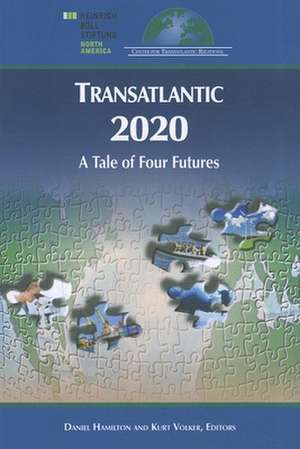Transatlantic 2020: A Tale of Four Futures
Editat de Daniel S. Hamilton, Kurt Volkeren Limba Engleză Paperback – 26 oct 2011
This volume examines fundamental societal, economic, political, and security trends affecting the EU and the U.S. over the next decade. It posits what such trends could mean for the transatlantic partnership by 2020, and, using policy scenarios, recommends the choices likely to influence those patterns.
What will the rise of Asia and the BRICs (Brazil, Russia, India, and China) mean for Europe and the United States? How might the consequences differ for the transatlantic partners, and what would that mean for the transatlantic partnership itself? What demographic trends will influence Europe and North America, how will the impact differ, and what effect could this have on the transatlantic partnership? How will trends in demographic change, trends in human mobility, and changes in energy sustainability affect each side of the Atlantic, how will these effects differ for each partner, and what might be the consequences for the partnership? These are the issues explored in this important study.
What will the rise of Asia and the BRICs (Brazil, Russia, India, and China) mean for Europe and the United States? How might the consequences differ for the transatlantic partners, and what would that mean for the transatlantic partnership itself? What demographic trends will influence Europe and North America, how will the impact differ, and what effect could this have on the transatlantic partnership? How will trends in demographic change, trends in human mobility, and changes in energy sustainability affect each side of the Atlantic, how will these effects differ for each partner, and what might be the consequences for the partnership? These are the issues explored in this important study.
Preț: 142.24 lei
Preț vechi: 157.71 lei
-10% Nou
Puncte Express: 213
Preț estimativ în valută:
27.23€ • 29.58$ • 22.88£
27.23€ • 29.58$ • 22.88£
Carte indisponibilă temporar
Doresc să fiu notificat când acest titlu va fi disponibil:
Se trimite...
Preluare comenzi: 021 569.72.76
Specificații
ISBN-13: 9780984134151
ISBN-10: 0984134158
Pagini: 313
Ilustrații: Illustrations
Dimensiuni: 152 x 229 x 25 mm
Greutate: 0.52 kg
Editura: Brookings Institution Press
Colecția Center for Transatlantic Relations SAIS
ISBN-10: 0984134158
Pagini: 313
Ilustrații: Illustrations
Dimensiuni: 152 x 229 x 25 mm
Greutate: 0.52 kg
Editura: Brookings Institution Press
Colecția Center for Transatlantic Relations SAIS
Notă biografică
Daniel S. Hamilton is the Richard von Weizsäcker Professor and director of the SAIS Center for Transatlantic Relations, Johns Hopkins University. He also serves as the executive director of the American Consortium for EU Studies in Washington, D.C.
Descriere
This volume examines fundamental societal, economic, political, and security trends affecting the EU and the U.S. over the next decade. It posits what such trends could mean for the transatlantic partnership by 2020, and, using policy scenarios, recommends the choices likely to influence those patterns.
What will the rise of Asia and the BRICs (Brazil, Russia, India, and China) mean for Europe and the United States? How might the consequences differ for the transatlantic partners, and what would that mean for the transatlantic partnership itself? What demographic trends will influence Europe and North America, how will the impact differ, and what effect could this have on the transatlantic partnership? How will trends in demographic change, trends in human mobility, and changes in energy sustainability affect each side of the Atlantic, how will these effects differ for each partner, and what might be the consequences for the partnership? These are the issues explored in this important study.
What will the rise of Asia and the BRICs (Brazil, Russia, India, and China) mean for Europe and the United States? How might the consequences differ for the transatlantic partners, and what would that mean for the transatlantic partnership itself? What demographic trends will influence Europe and North America, how will the impact differ, and what effect could this have on the transatlantic partnership? How will trends in demographic change, trends in human mobility, and changes in energy sustainability affect each side of the Atlantic, how will these effects differ for each partner, and what might be the consequences for the partnership? These are the issues explored in this important study.
